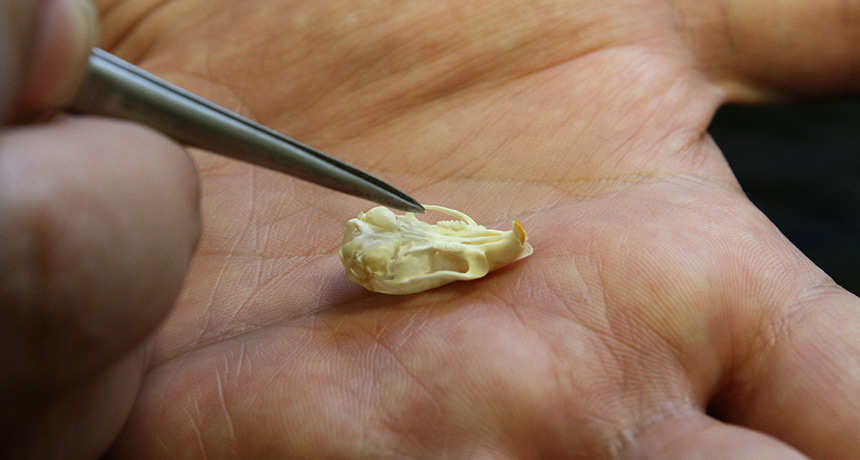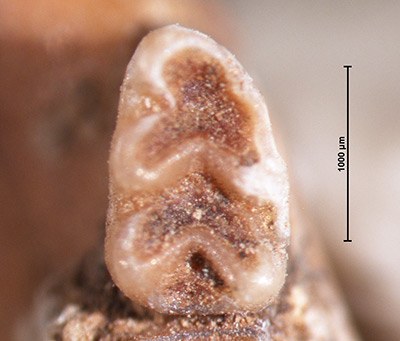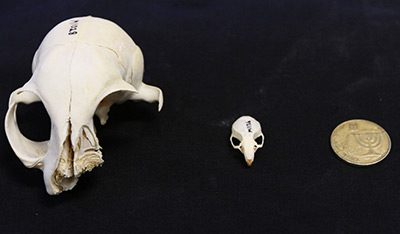How the house mouse found its home
Small human settlements helped one mouse species out-compete its rivals

When humans built settlements, house mice tagged along. Tiny mouse teeth helped archaeologists find clues of how these animals lived nearly 15,000 years ago.
University of Haifa
Got a mouse in the house? Blame yourself. Not your housekeeping, but your species. People never intended to live a mouse-friendly lifestyle. But as we adopted a settled life, some animals settled in, too, a new study shows. The success of some ancient mice followed the ups and downs of the earliest human settlements, new data show. When these communities of people thrived, certain mice did, too.
For their new study, scientists compared ancient mouse teeth with those of modern rodents that hang out near people who are only semi-settled. When humans make permanent homes, one mouse species moves in. When those people move on, another mouse species takes over.
These findings show that human settlements started long before people began to grow crops. And that suggests that the vermin were thriving off of our homes, not off of our stored food, the scientists conclude.
Between 15,000 and 11,000 years ago (a time called the Natufian period), people began to form small stone settlements in what is now Israel and Jordan. These communities were not yet farming or storing grain. People lived in a single place for a season or two. After moving on, they’d later come back to that place fairly often. By creating such a home base, those early settlers changed the ecosystem. Local plants and animals took advantage of new chances to grow and thrive.
Lior Weissbrod is an archaeologist in Israel at the University of Haifa. He looks for clues to the history of relationships between animals and people. He has always been interested in animal remains. But mouse teeth weren’t his first choice, he admits. “[At] the site I was going to work on, the remains of larger animals were already studied,” he says. “I was left with the small mammals.”

Small mammals have really tiny teeth. The largest mouse molars are only about 1 millimeter (0.04 inch) long. To collect them, Weissbrod spent a lot of time sifting dirt through a sieve with a very fine mesh. He collected 372 mouse teeth from the dirt at five archaeological sites in what is now Israel and Jordan. Those remains are 11,000 to 200,000 years old.
He gave the teeth to his colleague Thomas Cucchi. He’s an archaeologist at the National Museum of Natural History in Paris, France. Cucchi developed a technique to classify the mouse teeth by species. He did this based on tiny differences in their shape.
The human settlements Weissbrod studied had contained only a few homes each. But this small change for people was important to the tiny rodents. Based on the mouse teeth, it was clear that before people came along, the mouse species Mus macedonicus (Maeh-seh-DON-ih-kus) scurried through the undergrowth. After people and their stone buildings arrived, another species dominated — Mus domesticus (Doh-MES-tih-kus). When people left these settlements for about 1,000 years some 12,000 years ago, the reverse occurred: M. domesticus left and M. macedonicus returned.
The two species probably competed with each other when humans were absent, Weissbrod now suspects. But when people were around, M. domesticus took advantage of people being around. These mice may have had more flexible diets. They could live off our trash. And they feared people less.
“Once you get humans into the picture and human settlements … there’s a creation of a new habitat,” he explains. And one species — M. domesticus — took advantage of it to out-compete others, he says.
Weissbrod and his colleagues published their findings March 27 in the Proceedings of the National Academy of Sciences.
Ancient vs. modern vermin
Ancient samples alone were not enough to make a strong connection between human settlements and which species won the rights to be called a house mouse. The scientists also needed to look at a modern living situation that resembled the lifestyle that was typical of ancient peoples. For this, Weissbrod’s group turned to the Maasai (Mah-SYE). These are a nomadic group of cattle herders in southern Kenya.
“Maasai are nothing like ancient hunter-gatherers,” he notes. “But we look at specific things that make them comparable.” Maasai herders tend to live in small groups. And these East Africans use those settlements over and over. “The Maasai aren’t sedentary. They are on the verge perhaps,” he explains. “So they move [often] but not to the extent of highly mobile nomadic groups. They move on a seasonal basis.”

Two mouse species belonging to the Acomys genus live around Maasai settlements. Acomys mice are often called spiny mice, though scientists think they are more closely related to gerbils. One species is more likely to live near to people, the other to prefer sites without humans. The mice are easy to distinguish. A. wilsoni (Wil-SO-nee) has a short tail. A. ignites (Ig-NY-tees) has a longer tail.
Archaeologists usually work with dry and dusty fossils. Live, wiggling spiny mice were a new challenge for Weissbrod. But he got over his disgust. He went to Kenya and scooped up 192 of these critters from both species.
Like their ancient kin, one modern mouse had a competitive advantage when people were present. A. ignites made up 87 percent of the mice caught hanging out with the Maasai. In the non-settled area, fewer than half belonged to this species.
Weissbrod, Cucchi and their colleagues combined all this information about ancient and modern mice and people. Their findings now show how house mice came to live alongside us — no grain or farming required.
“We can show with a high degree of certainty now that mice became attached to us 3,000 years before farming,” Weissbrod reports. “From that we learned hunter-gatherers were making the transition to sedentary lives before farming. They didn’t need the crops to make that transition.”
Melinda Zeder is an archaeologist at the Smithsonian Institution in Washington, D.C. She wasn’t involved in the study. Zeder finds the new study “wonderful.” It’s impressive that such a big finding could come from such small samples, she says. “Out of the mouths of mice, we’re getting a wonderful view of a pivotal time in history.”
Other species also have taken the opportunity to hang out with people, Zeder notes. Wolves and wild boar arrived and “auditioned themselves for a starring role as a domesticate.” A few of the friendlier ones began to interact more with people. Those people began to see the advantages of the animals. By choosing to breed certain animals with each other, humans were able to select traits they prized. From wolves came dogs, and from wild boar came today’s pigs.
But when humans weren’t paying attention, other species moved in and thrived without the help of human breeders. Mice aren’t the only vermin that have arrived to “domesticate themselves,” Weissbrod says. Sparrows, pigeons, rats and other species have taken advantage of our presence. People may not find them useful. But that won’t stop them from using us.







